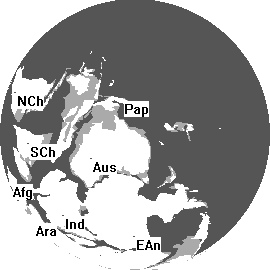|
History of the Universe eBook. 398 pages, 300 illustrations only £5.99
Devonian Period 416 to 359 myaSummaryThe Devonian is called the "Age of Fishes" because fish diversified in the ocean, but in fact all forms of advanced life diversified to an astonishing degree during this period. The Devonian is named after the English county Devon where its rocks were first recognized. The continents were mostly gathered into two supercontinents: either Gondwana (in the south) or Euramerica further north. The climate was warm and dry. Increasingly sophisticated plants and arthropods lived on these lands, and this new food source attracted the attention of the first four-footed vertebrates which began to emerge from the seas. Continents 400 mya
Earth 400 mya. Click here for key. Previous image. Next image. Image courtesy of TimeTrek At the start of the Devonian, the ancestors of North America (Laurentia), Greenland and the lands surrounding the Baltic Sea (Baltica) collided to form the supercontinent of Euramerica which straddled the equator. This is also known as the Old Red Sandstone Continent.
Image courtesy of TimeTrek Further south, the supercontinent Gondwana still covered the South Pole. The rest of the Earth consisted of a huge ocean. ClimateDuring most of the Devonian there were no glaciers, the land was warm and dry containing deserts. These later turned into the sandstone which is typical of the period. PlantsAlthough known as the Age of Fishes, the Devonian also saw plants and invertebrates first conquer the land. At the start of the Devonian, plants were still tied to the water, requiring a moist environment to reproduce.
Image of lycopods courtesy of Anne Burgess By the middle of the period, lycopods, ferns horsetails and the ancestors of gymnosperms were growing. The horsetails shown above are therefore living fossils. By the end of the period, various plants had become as tall as trees which used broad leaves to capture light energy. InvertebratesThe invertebrates grew readily in the warm oceans. Ammonites first appeared. The fossils of these extinct relatives of the octopus are still common. Reefs grew rapidly as corals diversified. Others followed the plants onto the land, scorpions and insects resembling modern silverfish.
History of the Universe eBook. 398 pages, 300 illustrations only £5.99 |
eBook only £5.99 398 pages, 300 images  "I find the science fabulous...an extremely useful teaching tool." Professor David Christian. Follow @WykenSeagrave |

The complete history of the Universe -- from the Big Bang to 200 my into the future


